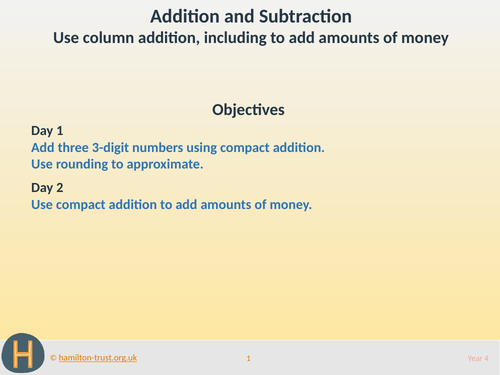




This presentation provides two days of teaching that cover the objectives:
- Solve simple money problems involving decimals to 2 decimal places.
- Estimate, compare and calculate money in pounds and pence.
- Use column addition to add 3-digit numbers: first expanded, then compact method.
- Estimate and use inverse operations to check answers to a calculation.
It includes starter activities, whole class teaching, group activities, practice sheets and mastery questions. It can be used on a variety of interactive whiteboards.
Day 1 Teaching
Write 426 + 257 + 582 and 275 + 446 + 385. Estimate the answer to each addition. Point out that lots of the numbers round up so looking at the first digit only does not give a good estimate. Model using compact addition for the first addition. Compare with children’s estimates. Children use compact addition for 2nd addition, then for 726 + 457 + 582.
Day 2 Teaching
Show a complete compact addition for £3.55 + £2.76. Ask children to explain to their partners how this was done, talking through each stage. Discuss each stage. Show books with price labels: £4.79, £5.49, £5.25, £4.65, £4.29. Children collaborate to find totals of pairs for under £10.
This teaching is part of Hamilton’s Year 4 Addition and Subtraction block. Each Hamilton maths block contains a complete set of planning and resources to teach a term’s worth of objectives for one of the National Curriculum for England’s maths areas.
Something went wrong, please try again later.
This resource hasn't been reviewed yet
To ensure quality for our reviews, only customers who have purchased this resource can review it
Report this resourceto let us know if it violates our terms and conditions.
Our customer service team will review your report and will be in touch.
